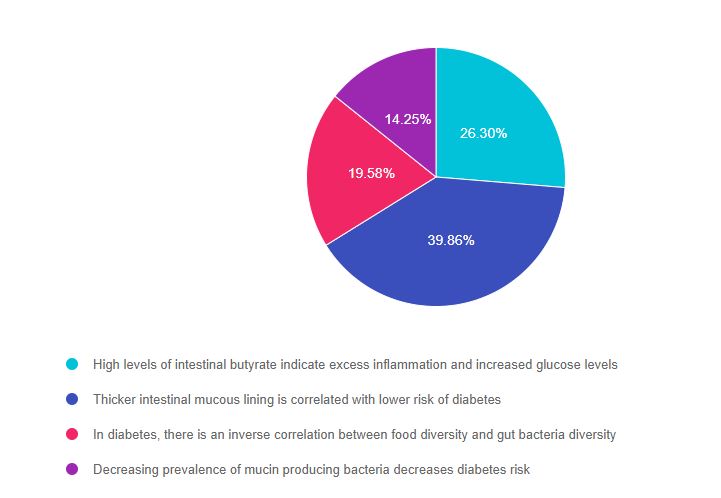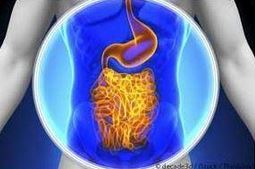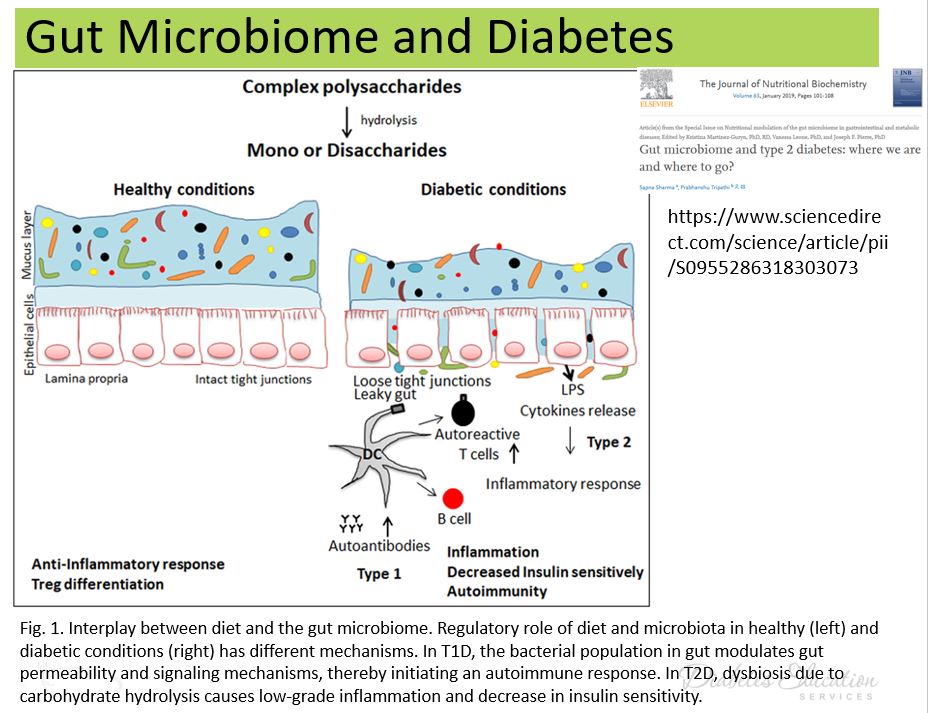
Our November 10th Question of the week quizzed test takers on intestinal bacterial health and diabetes. 40% of respondents chose the correct answer, while 60% did not. We thought that this was an important topic to discuss further, so we can pass on correct info to people living with diabetes.
Before we start though, if you don’t want any spoilers and haven’t tried the question yet, you can answer below: Answer Question
Question: Intestinal health and diabetes are co-related. Which of the following statements is true?
Answer Choices:
- High levels of intestinal butyrate indicate excess inflammation and increased glucose levels
- Thicker intestinal mucous lining is correlated with a lower risk of diabetes
- In diabetes, there is an inverse correlation between food diversity and gut bacteria diversity
- Decreasing the prevalence of mucin-producing bacteria decreases diabetes risk

As shown above, the most common choice was option 2, the second most common answer was option 1, then option 3, and finally option 4.
Getting to the Best Answer
If you are thinking about taking the certification exam, this practice test question will set you up for success. Test writers anticipate possible answers based on the details in the question. They will wave those “juicy answers” right under your nose. Your job is to weed through the particulars, pluck out the most important elements and choose the BEST answer.
Answer 1 is incorrect. 26.30% chose this answer. “High levels of intestinal butyrate indicate excess inflammation and increased glucose levels.”
Butyrate is one of the main metabolites produced in the colon by bacterial fermentation of dietary fiber. When it comes to gut health, higher levels of butyrate, a short-chained fatty acid, indicate higher fiber consumption and overall gut health and happiness.
Answer 2 is correct. 39.86% of you chose this answer. “Thicker intestinal mucous lining is correlated with a lower risk of diabetes”.
The image to the right is a great illustration. You can see that the thicker the mucus lining in the intestinal lumen, the less overall inflammation and leaky gut. A diet high in fiber feeds the microbiota in charge of maintaining a thick and healthy mucous lining.
Answer 3 is incorrect. About 19.58% of respondents chose this. “In diabetes, there is an inverse correlation between food diversity and gut bacteria diversity”
There is actually a direct correlation between food diversity and gut bacterial diversity. Enjoy a rainbow of foods, with lots of veggies, seeds, legumes, nuts, fruit, and whole grains.
Finally, Answer 4 is incorrect. 14.25% chose this answer. “Decreasing the prevalence of mucin-producing bacteria decreases diabetes risk.”
Mucin producing bacteria, like Akkermansia Muciniphila, help maintain a healthy mucus lining in the intestinal lumen. This is associated with less overall inflammation and leaky gut. A diet high in fiber feeds the microbiota in charge of maintaining a thick and healthy mucous lining.
We hope you appreciate this week’s rationale!
To learn more about this exciting topic, please join our
FREE Webinar Recorded & Ready for Viewing – Getting to the Gut & Skin, Meet Your Microbiome
Join the wonderment as we explore the role of our Microbiome.

“This Webinar is filled with Bev’s energy, knowledge, and passion for diabetes that she replicates in all her teachings. She puts a demand on herself to be a mentor to all. Her information is well organized, full of current/relevant research, and helps CDCES’ view into the future as a changing world impacts diabetics. I find her to be the most exciting and engaging educator and … OUTSTANDING teacher!!” – recent participant
New Webinar topics:
- Discuss the latest research on our microbiome
- Describe the link between COVID and gut bacterial health
- Discuss the role of the skin microbiome in health and body weight
- Describe the importance of diet during pregnancy to promote the baby’s healthy microbiome.
- State the relationship between gut health and diabetes risk
- Describe 3 strategies to get our microbiome back to better health.
This one-hour complimentary journey will expand your view of how the trillions of bacterial hitchhikers profoundly influence our health. We will discuss how foods, the environment, and our medical practices have impacted our gut bacteria over time and strategies we can take to protect these old friends.
Sign up for Diabetes Blog Bytes – we post one daily Blog Byte from Monday to Friday. And of course, Tuesday is our Question of the Week. It’s Informative and FREE! Sign up below!
[yikes-mailchimp form=”1″]Accreditation: Diabetes Education Services is an approved provider by the California Board of Registered Nursing, Provider 12640, and Commission on Dietetic Registration (CDR), Provider DI002. Since these programs are approved by the CDR it satisfies the CE requirements for the CDCES regardless of your profession.*
The use of DES products does not guarantee the successful passage of the CDCES exam. CBDCE does not endorse any preparatory or review materials for the CDCES exam, except for those published by CBDCE.
Rationale of the Week | Hyperglycemia and Cystic Fibrosis [yikes-mailchimp form=”1″]










